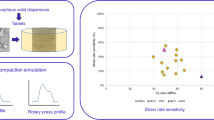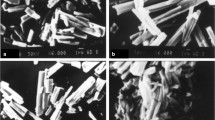Abstract
Purpose. Poorly compressible crystals of acebutolol hydrochloride were agglomerated by the spherical crystallization technique with a two-solvent system to improve the compressibility for direct tabletting. The mechanism of improvements in static compression behaviors and tablettabilities of the spherically agglomerated crystals were investigated.
Methods. The improvement of static compression behaviors of the agglomerated crystals was determined by measuring the stress relaxations and elastic recoveries of compressed powder of original and agglomerated crystals. The improved tablettability of agglomerated crystals was evaluated by the pressure transmission ratio upon compression, the ejection pressure for releasing the tablet from the die and the tablet strength, i.e., tensile strength required for breaking.
Results. The higher relaxation pressure and the lower elastic recovery of the agglomerated crystals than of the original crystals were found. The pressure transmission ratio data showed that the friction pressures of the two crystals were similar during the compression period. The ejection pressure of the agglomerated crystals was lower than that of the original crystals. The tensile strength of the tablet of agglomerated crystals was greater than that of the original crystals.
Conclusions. The compressibility and tablettability of the spherically agglomerated crystals prepared by the spherical crystallization technique were much improved due to their increased plastic property and reduced adhesive property compared to the original crystals.
Similar content being viewed by others
REFERENCES
Y. Kawashima. Development of Agglomerated Crystallization Technique Using New Agglomeration Phenomena of Particles in Liquid System and Particle Designs for Pharmaceutical Preparations. Yakugaku Zasshi 106: 433–445 (1986).
Y. Kawashima, H. Takeuchi, T. Niwa, T. Hino, M. Yamakoshi and K. Kihara. The Development of a Novel Emulsion-Solvent-Diffusion Preparation Method of Agglomerated Crystals for Direct Tableting and Evaluation of Their Compressibilities. J.Soc.Powder Technol. Japan 26: 659–665 (1989).
Y. Kawashima. Spherical Crystallization as a Novel Particle Design Technique for the Development of Pharmaceutical Preparations. Kona 5: 69–75 (1987).
Y. Kawashima, F. Cui, H. Takeuchi, T. Niwa, T. Hino and K. Kihara. Agglomeration Behaviour and Modification of Spherical Crystallization Process of Pharmaceuticals by the Emulsion-Solvent-Diffusion Method and Proposed Closed-Circuit Batch System. Yakugaku Zasshi 111: 451–462 (1991).
F. Cui, Y. Kawashima, H. Takeuchi, T. Niwa, T. Hino, and K. Kihara. Preparation of Pharmaceutical Agglomerated Crystals for Direct Tableting with an Emulsion-Solvent-Diffusion Method. The 6th Symposium on Particulate Preparation and Designs, Japan 6: 70–74 (1989).
Y. Kawashima, F. Cui, H. Takeuchi, T. Niwa, T. Hino and K. Kiuchi. Improvements in Flowability and Compressibility of Pharmaceutical Crystals for Direct Tableting by Spherical Crystallization with a Two-Solvent System. Powder Technol. 78: 151–157 (1994).
J.N. Staniforth. Advances in Excipient Technology Powder and Tableting Characteristics. S.T.P. Pharma. 6: 162–168 (1990).
C.I. Patel and J.N. Staniforth. Determination of the Apparent Failure Viscosity of Tablets. J. Pharm. Pharmacol. 39: 647–650 (1987).
H. C. M. Yu, M. H. Rubinstein, I. M. Jackson and H. M. Elsabbagh. Multiple Compression and Plasto-Elastic Behaviour of Paracetamol and Microcrystalline Cellulose Mixtures. J. Pharm. Pharmacol. 40: 669–673 (1988).
C. I. Patel, J. N. Staniforth and J. P. Hart Determination of True Work of Compaction, J. Pharm. Pharmacol. 39: 30p (1987)
H. A. Janssen. Versuche über Getreidedruck in Silozellen. Zeitschrift Vereines Deutscher Ing. 39: 1045–1049 (1895).
J. Lloyd, P. York and G. D. Cook. Influence of Compression Rate on the Mechanical Properties of Compacts. 6th International Conference on Pharm. Technol. 4: 189–195 (1992).
J. E. Rees and S. Malamataris. A Possible Use of Creep Analysis to Determine Optimum Loading Conditions for Precompression. 6th International Conference on Pharm. Technol. 4: 179–188 (1992).
A. N. Armstrong and L. P. Blundell. The Effect of Machine Speed on the Compaction of Some Directly Compressible Tablet Diluents. J. Pharm. Pharmacol. 39: 28p (1987).
J. J. Benbow. Chapter 7, Mechanisms of Compaction, Enlargement and Compaction of Particulate Solids, ed. by Nayland G Stanley-Wood, Butterworths, London, pp. 161–177 (1983).
Author information
Authors and Affiliations
Rights and permissions
About this article
Cite this article
Kawashima, Y., Cui, F., Takeuchi, H. et al. Improved Static Compression Behaviors and Tablettabilities of Spherically Agglomerated Crystals Produced by the Spherical Crystallization Technique with a Two-Solvent System. Pharm Res 12, 1040–1044 (1995). https://doi.org/10.1023/A:1016266600113
Issue Date:
DOI: https://doi.org/10.1023/A:1016266600113




